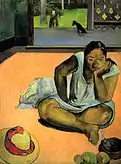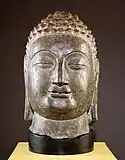Worcester Art Museum
The Worcester Art Museum, also known by its acronym WAM, houses over 38,000 works of art dating from antiquity to the present day and representing cultures from all over the world. WAM opened in 1898 in Worcester, Massachusetts, and ranks among the more important art museums of its kind in the nation. Its holdings include some of the finest Roman mosaics in the United States, outstanding European and American art, and a major collection of Japanese prints. Since acquiring the John Woodman Higgins Armory Collection in 2013, WAM is also home to the second largest collection of arms and armor in the Americas.[2] In many areas, it was at the forefront in the US, notably as it collected architecture (the Chapter House, 1932),[3] acquired paintings by Monet (1910) and Gauguin (1921),[4] presented photography as an art form (1904)[5] The Worcester Art Museum also has a conservation lab[6] and year-round studio art program for adults and youth.[7]
.jpg.webp) Salisbury Street facade | |

| |
| Established | 1898 |
|---|---|
| Location | 55 Salisbury Street Worcester, Massachusetts |
| Coordinates | 42.273007°N 71.802029°W |
| Type | Art museum |
| Director | Matthias Waschek[1] |
| Architect | Stephen C. Earle |
| Public transit access | MBTA Worcester |
| Website | Worcester Art Museum |
History
In September 1896, Stephen Salisbury III and a group of his friends founded the Art Museum Corporation to build an art institution "for the benefit of all." Salisbury then gave a tract of land, on what was once the Salisbury farm (now fronting Salisbury Street in Worcester, Massachusetts), as well as $100,000 USD to construct a building designed by Worcester architect Stephen C. Earle. The museum formally opened in 1898 with the Rev. Daniel Merriman as its first president.[8][9] The museum's collection then consisted largely of plaster casts of "antique and Renaissance" sculptures, as well as a selection of 5,000 Japanese prints, drawings, and books, willed to the museum from John Chandler Bancroft, son of John Bancroft.[8]
In 1905, Stephen Salisbury died and left the bulk of his five million-dollar estate to the museum.[10] The Worcester Art Museum continued to grow and slowly amassed one of the important art collections in the country, with some of the significant early works donated or loaned by the artist and collector Helen Bigelow Merriman.[9]
Between 1932 and 1939, the Worcester Art Museum joined a consortium of museums and institutions to sponsor expeditions to the archaeological sites where the city of Antioch once stood. This group of museums, including Princeton University, the Musée du Louvre, the Baltimore Museum of Art, and Harvard University's affiliate, Dumbarton Oaks, discovered hundreds of intricate floor mosaics. The Antioch mosaics, as they are now known, were split up among the institutions The WAM received many mosaics including the Worcester Hunt, which is now installed in the Renaissance Court's floor.[11]
On May 17, 1972, the museum suffered a major theft of artwork. Two men wearing masks entered the museum just before closing.[12][13] The two men stole The Brooding Woman and Head of a Woman by Paul Gauguin, Mother and Child by Pablo Picasso, and St. Bartholomew, then attributed to Rembrandt, a collection of works worth over one million dollars.[14][13] Four individuals were charged with the theft as well as the theft of seven artworks stolen from the Boyden Library at Deerfield Academy.[12]
In 2013, Worcester’s Higgins Armory Museum closed its doors and its renowned collection of arms and armor was integrated into WAM’s.[15][2] A permanent arms and armor gallery will open no later than 2023; in the meantime, major works from the Higgins collection are on view in galleries throughout the museum, alongside Greek, Roman, Asian, and European works of art. The museum is also rethinking its institutional narrative, leveraging the quality and depth of the collection to tell a story that is an alternative to those told by other museums in the area. The guiding principle for this endeavor is WAM’s new mission statement (adopted in 2017): The Worcester Art Museum connects people, communities, and cultures through the experience of art.
Architecture

The Worcester Art Museum started as a small three-story building, designed by Stephen Earle and constructed by Messrs. Norcross Brothers, in 1898.[4] Very little of the exterior of this original building can be viewed due to the multiple expansions the museum has undertaken.
In 1927, the museum purchased a 12th-century French chapter house that was originally part of the Benedictine Priory of St. John at Le Bas-Nueil near Poitiers. Installed in 1932, and linked to the museum in 1933 via the grand Renaissance Court, the chapter house was the first medieval building ever transported from Europe to America.[13] Decorating the Renaissance Court floor is unequivocally one of Worcester's greatest ancient treasures – a group of Antioch mosaics dating from the first through the sixth century A.D, which was excavated at Antioch in Syria.
The museum building has expanded several times, in 1940, 1970 (Higgins Education Wing addition), and 1983 (Frances L. Hiatt Wing). The Frances L. Hiatt Wing is designed for special exhibitions; study and storage area for prints, drawings, and photographs; and an expanded conservation area. The Higgins Education Wing contains studios and classrooms, a professional printmaking studio, a computer studio, photography lab, and an exhibition space for student works.
In November 2015, the museum unveiled a new walkway ramp at the Salisbury Street entrance. Designed by Kulapat Yantrasast of wHY Architects, the bridge-like structure boldly combines contemporary design with the museum’s 1933 Beaux-Arts exterior while making the historic main entrance fully accessible.
Collection


In addition to the Roman, mosaic-laden, Renaissance court and French chapter house, strengths of the permanent collection include collections of European and North American painting, prints, photographs, and drawings; Asian art; Greek and Roman sculpture and mosaics; and Contemporary art.
European paintings include some Flemish Renaissance paintings, an El Greco, a Rembrandt, and a room of Impressionist and 20th-century works by Monet, Matisse, Renoir, Gauguin, and Kandinsky. The American painting collection includes works by Thomas Cole, Winslow Homer, John Singer Sargent, William Morris Hunt, Elizabeth Goodridge, among others. In the 20th-century gallery, the Museum displays works by Franz Kline, Jackson Pollock, and Joan Mitchell.
In 1901, John Chandler Bancroft, a wealthy Bostonian, bequeathed more than 3,000 Japanese prints. The Bancroft Collection spans the history of woodcut printmaking in Japan, with particular strength in rare, early images from the late 17th and 18th centuries. Salisbury's estate donation included many portraits commissioned by his family, as well as sculpture, furniture, and silver. These works, by artists such as Gilbert Stuart, Thomas Crawford, and Samuel F.B. Morse and the craftsmen Paul Revere, Edward Winslow, and Nathanial Hurd, constituted the nucleus of the American collections.[16]
American Art
_and_Baby_Mary_Freake-Gibbs_Painter_1671%E2%80%931674.jpg.webp) Freake-Gibbs Painter, Elizabeth Clarke Freake (Mrs. John Freake) and Baby Mary, 1671–1674
Freake-Gibbs Painter, Elizabeth Clarke Freake (Mrs. John Freake) and Baby Mary, 1671–1674 Freake-Gibbs Painter, John Freake, 1671–1674
Freake-Gibbs Painter, John Freake, 1671–1674 Winslow Homer, The Gale, 1883–1893
Winslow Homer, The Gale, 1883–1893 John La Farge, Peacock Window, 1892–1908
John La Farge, Peacock Window, 1892–1908 Edward Augustus Brackett, Shipwrecked Mother and Child, 1848-1851
Edward Augustus Brackett, Shipwrecked Mother and Child, 1848-1851 Paul Revere, Paine Service, 1773
Paul Revere, Paine Service, 1773
European Art
 Piero di Cosimo, The Discovery of Honey by Bacchus, about 1499
Piero di Cosimo, The Discovery of Honey by Bacchus, about 1499 Attributed to Leonardo da Vinci and Lorenzo di Credi, A Miracle of Saint Donatus of Arezzo, about 1479
Attributed to Leonardo da Vinci and Lorenzo di Credi, A Miracle of Saint Donatus of Arezzo, about 1479_-_IMG_7281.JPG.webp) Thomas Gainsborough, Portrait of the Artist's Daughters, 1763-64
Thomas Gainsborough, Portrait of the Artist's Daughters, 1763-64 Paul Gauguin, Te Faaturuma (The Brooding Woman), 1891
Paul Gauguin, Te Faaturuma (The Brooding Woman), 1891
Asian Art
 Torii Kiyonobu I, Actor Sawamura Kodenji I as Tsuyu-no-Mae, 1698
Torii Kiyonobu I, Actor Sawamura Kodenji I as Tsuyu-no-Mae, 1698 Mughal (Basawan), Birth of Ghazan Khan, from a manuscript of the "Jami'al-Tawarikh" by Rashid al-Din (1247-1318), about 1596
Mughal (Basawan), Birth of Ghazan Khan, from a manuscript of the "Jami'al-Tawarikh" by Rashid al-Din (1247-1318), about 1596 Chinese, Northern Wei Dynasty, Head of a Buddha, 550–770
Chinese, Northern Wei Dynasty, Head of a Buddha, 550–770
Arms and Armor
 Nagasone Tojiro Mitsumasa, Helmet in the form of a Sea Conch Shell, 1618
Nagasone Tojiro Mitsumasa, Helmet in the form of a Sea Conch Shell, 1618 Stefan Rormoser, Armor for Field and Tilt, of Count Franz von Teuffenbach (1516-1578), 1554
Stefan Rormoser, Armor for Field and Tilt, of Count Franz von Teuffenbach (1516-1578), 1554 Workshop of Hans Sumersperger, "Gothic" Hunting Sword, about 1490–1500
Workshop of Hans Sumersperger, "Gothic" Hunting Sword, about 1490–1500
Directors
- Philip T. Gentner 1908–1917
- Raymond Wyer (changed his name in 1923 to Raymond Henniker-Heaton) 1918–1925
- George W. Eggers 1926–1930
- Francis Henry Taylor 1931–1939
- Charles H. Sawyer 1940–1947
- Louisa Dresser Campbell (Acting Director) 1943–1946
- George L. Stout 1947–1955
- Francis Henry Taylor 1955–1957
- Daniel Catton Rich 1958–1970
- Richard Stuart Teitz 1970–1981
- Tom L. Freudenheim 1982–1986
- James A. Welu 1986–2011
- Matthias Waschek 2011 –
Management
The Worcester Art Museum operates on a $10M annual budget and is governed by an active 25-member Board of Trustees, made up of local, national, and international members with expertise in finance, investment, museum management, art history, education, and real estate development. In addition, WAM has a 200-member Corporation and over 3,000 members and 100 Business Partners. It employs 65 full-time and 128 part-time personnel (including 56 professional artist faculty) and enlists hundreds of volunteers and docents. In November 2017, the Museum was awarded reaccreditation by the American Alliance for Museums.
Prior to becoming Director of WAM in 2011, Matthias Waschek, PhD, served as Executive Director and Curator of the Pulitzer Arts Foundation (2003–2011) and Head of Academic Programs at the Louvre Museum in Paris (1992–2003).
References
- "New Director Announced". Worcesterart.org. 2014-02-13. Retrieved 2014-06-25.
- Loos, Ted (19 March 2014). "What Comes Next, After the Troops Are Dismissed" – via NYTimes.com.
- "Worcester Art Museum – Chapter House". www.worcesterart.org.
- "Worcester Art Museum – The Brooding Woman". www.worcesterart.org.
- "Photography at the Worcester Art Museum: Keeping Shadows," by David Acton, copyright 2004 Worcester Art Museum (ISBN 0-936042-10-9)
- "Worcester Art Museum – Conservation at the Worcester Art Museum". www.worcesterart.org.
- "classes". portal.worcesterart.org.
- New Art Museum. New York Times. July 6, 1902. Retrieved February 21, 2011
- Welu, James. "Helen Bigelow Merriman and the Worcester Art Museum". Holy Cross College website.
- Salisbury's Bequests. November 21, 1905. Retrieved February 21, 2011
- Worcester Art Museum Restores Border Panels to Worcester Hunt, Largest Antioch Floor Mosaic in America. Worcester Art Museum. Retrieved January 26, 2011
- Suspects in Art Theft Face Court on June 1. The Telegraph. May 23, 1972. Retrieved February 21, 2011.
- Thieves Take Art Works. Victoria Advocate. May 18, 1972. Retrieved February 21, 2011
- Miner, Bradford. "40 years since heist at Worcester Art Museum". Telegram. Retrieved 25 July 2012.
- Duckett, Richard (8 March 2013). "Higgins Armory Museum to close after 82 years". Worcester Telegram and Gazette. Retrieved 8 March 2013.
- Judith H. Dobrzynski (March 14, 2012), How an Acquisition Fund Burnishes Reputations New York Times.
